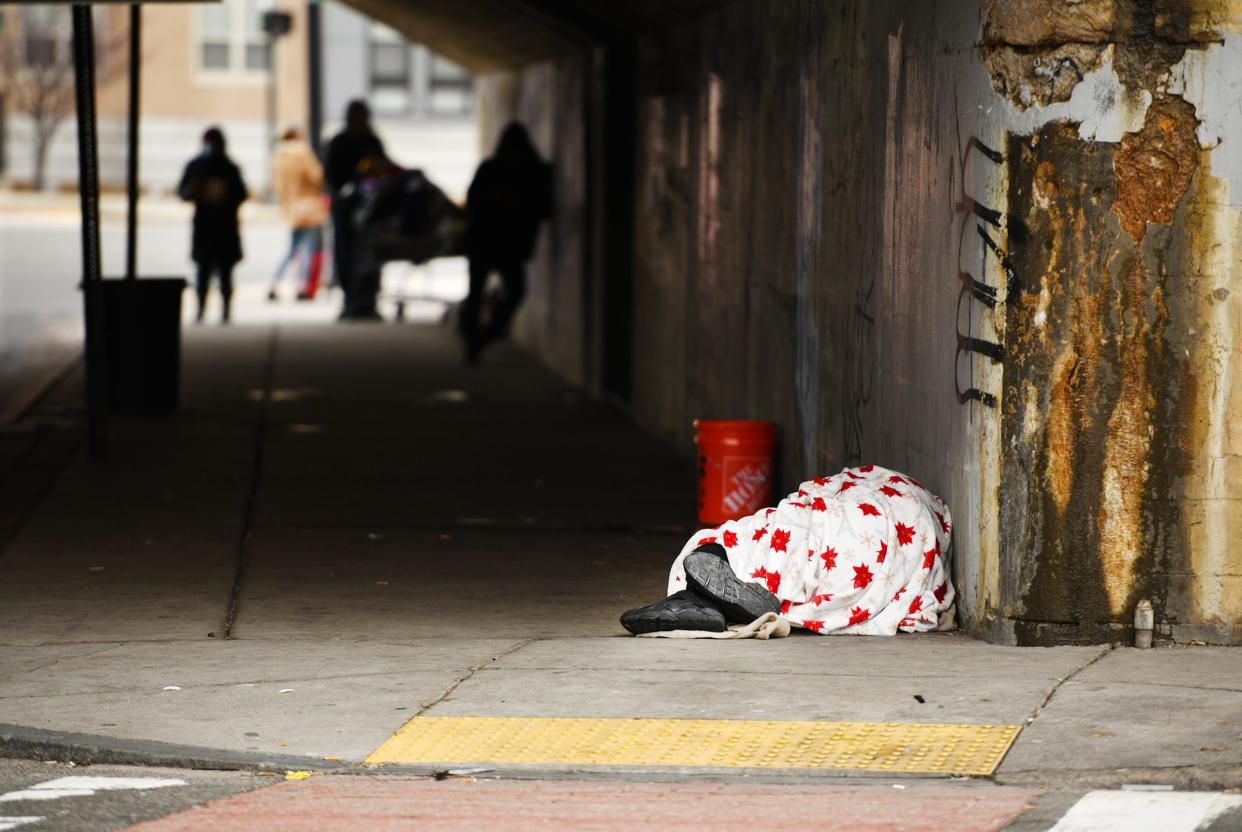Homelessness continues to climb in Worcester with more unsheltered, report says

WORCESTER ― The number of people who are homeless in the city continues to rise, with a particular increase in the unsheltered population this November compared with last, according to data presented to the city’s Human Rights Commission Monday night.
“In the city itself we’re seeing more homelessness and a greater number of unsheltered individuals,” Eniya Lufumpa, who earned a doctorate in public health, epidemiology and biostatistics and is the city’s director of homeless services, said in a follow-up interview Tuesday. “But where we’re seeing the major difference is the increase in people who are unsheltered.”
Data on the homeless population in the city is collected each month by the Central Massachusetts Housing Alliance, which counts adults who identify as homeless who are using support programs in the city as well as members of the unsheltered population. Support programs include Abby’s House, the homeless Triage Center, Living in Freedom Together and others. This data is unique to the city.
That data recorded 577 adults who were homeless as of Nov. 1, 2021. The number increased to 586 adults who were homeless as of Nov. 1, 2022.
Lufumpa said Tuesday that she expected the total increase to be higher, given several factors that contribute to homelessness in Worcester.
Primarily, there is a severe lack of affordable housing in the city.
“Housing continues to be a major issue in the city and across the country at this point,” Evis Terpollari, the city’s homeless projects manager, told the Human Rights Commission in a virtual meeting Monday evening.
Lufumpa noted that the average one-bedroom apartment in the city rents for $1,500 a month, which housing subsidies for homeless individuals will not cover. Moreover, low rental vacancy rates mean many people are competing for these apartments.
“There’s not a health department in Massachusetts that isn’t crying out that we need more housing,” Dr. Matilde Castiel, the city’s commissioner of health and human services, said Tuesday.
Worcester is also a hub for services the homeless population may use, which are not available in other communities.
“We know there is a need here, not just for folks who are here who are homeless but also for folks who are coming from other cities and towns who are looking for support services,” Terpollari told the Human Rights Commission. “We’re doing the best we can to meet demand.”
Opioid epidemic, economy among factors
Add in the opioid epidemic, a crisis surrounding access to mental health care (both factors which can lead to and perpetuate homelessness) as well as an inflationary economy, and it is not surprising that the homeless population is increasing in the city.
But the increase in the total homeless population increase is not as drastic as the increase in the number of those individuals who were unsheltered between November 2021 and November 2022.
Of the 577 total adults who were homeless in November 2021, 155 were unsheltered, according to the Central Massachusetts Housing Alliance.
Of the 586 total adults who were homeless in November 2022, 226 were unsheltered.
To be sure, Lufumpa noted, this winter has so far been milder than last, and the increase in unsheltered individuals corresponds with a decrease in the number of people in shelters, according to the housing alliance.
“This winter hasn’t been as cold, so for those who want to stay outside, they could,” Lufumpa said.
However, there is a total of 229 shelter beds in Worcester, according to city data. Given that there are 586 adults considered homeless, some people are certainly being forced to sleep outside.
Continual uptick in unsheltered
And while the data shows the total population of homeless individuals counted by the CMHA has peaked in the winter months in the last few years and then waned as the weather gets warmer, the number of those individuals who are unsheltered shows a continual uptick, regardless of the time of year.
To address the increase in homelessness and unsheltered individuals, the city and local nonprofit organizations have a multifaceted approach.
The first is a push to build more extreme-low-income housing with medical and social services for residents.
Several major projects are working toward this goal, including a tiny-homes village on Stafford Street, converting the Quality Inn on Oriol Drive into supportive housing, and a project for supportive housing on Lewis Street.
“We’re throwing all we have at the housing,” Terpollari said. “The city’s very invested in being able to create additional housing units for all of the homeless individuals who are coming into our pool.”
The city also works through Lufumpa’s department and the interdepartmental Quality of Life Team to connect homeless individuals with housing as well as mental health, medical, social and addiction services.
Working with other Mass. cities
Finally, the city is also working with the 14 largest cities in the state to collaborate on addressing the housing and homelessness crisis.
“We’re asking them, can they open more shelters, resources, etc., so they can have services as well and support the population in their city,” Lufumpa told the HRC.
Castiel was hopeful that these efforts will lead to a decrease in the homeless population.
“We have a sense that the awareness is there. We know more about addiction, the opioid epidemic and there are more people working together to end it - the same with mental health,” Castiel said.
She noted that the city reached functional zero homelessness in 2011, meaning it had reached the point where the homeless support system was able to prevent homelessness whenever possible.
“I think the conversation is out there now,” Castiel continued. “We know about the importance of housing.”
This article originally appeared on Telegram & Gazette: Worcester Human Rights Commission hears report on rising homelessness

